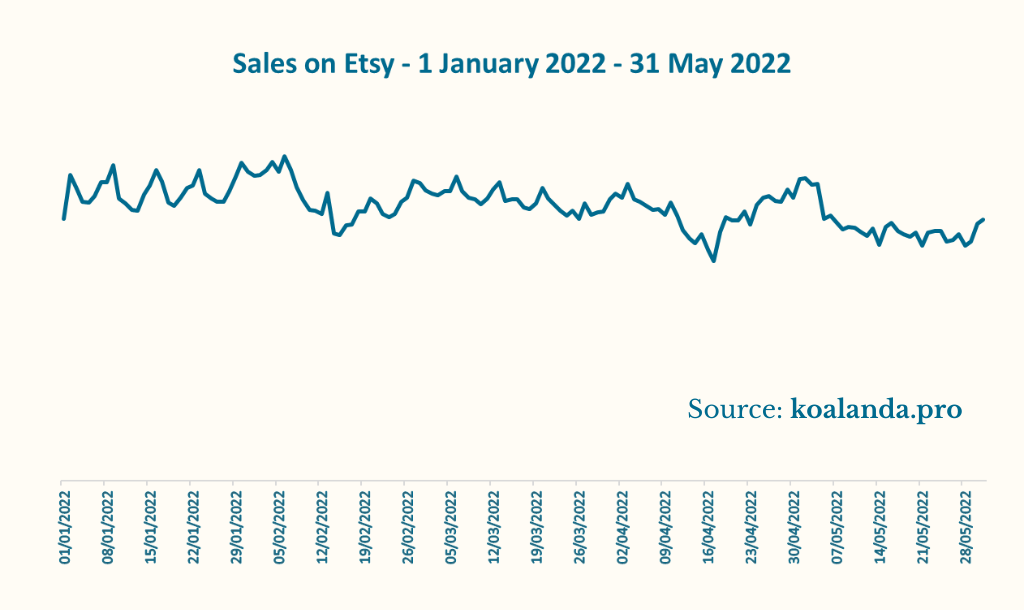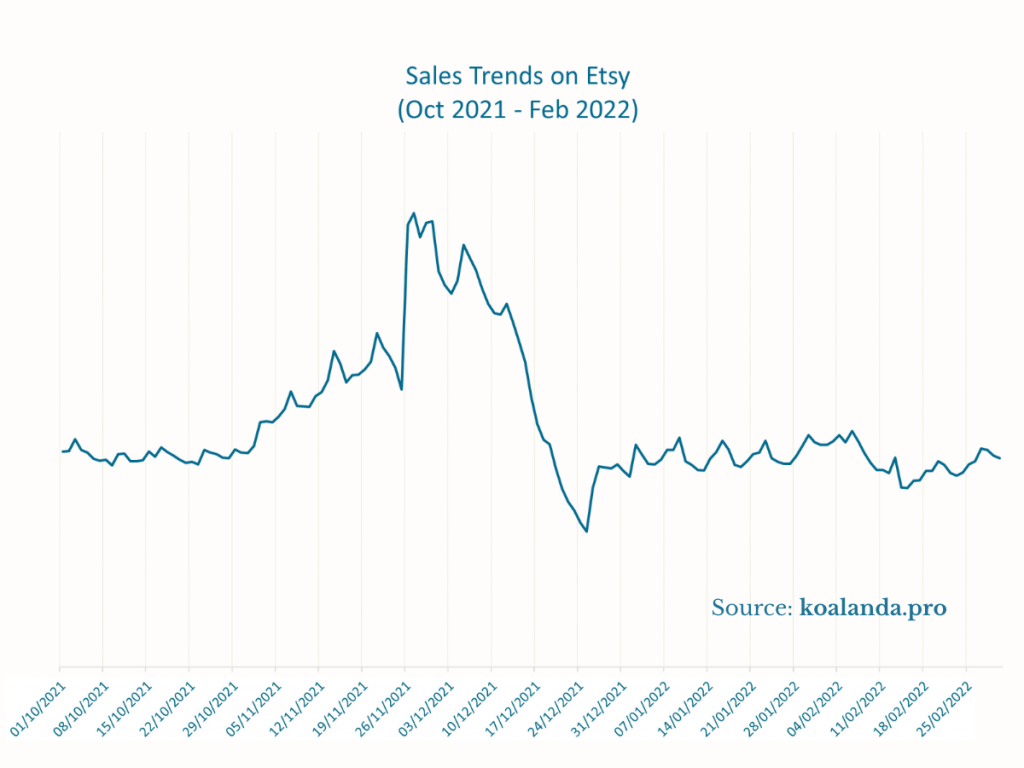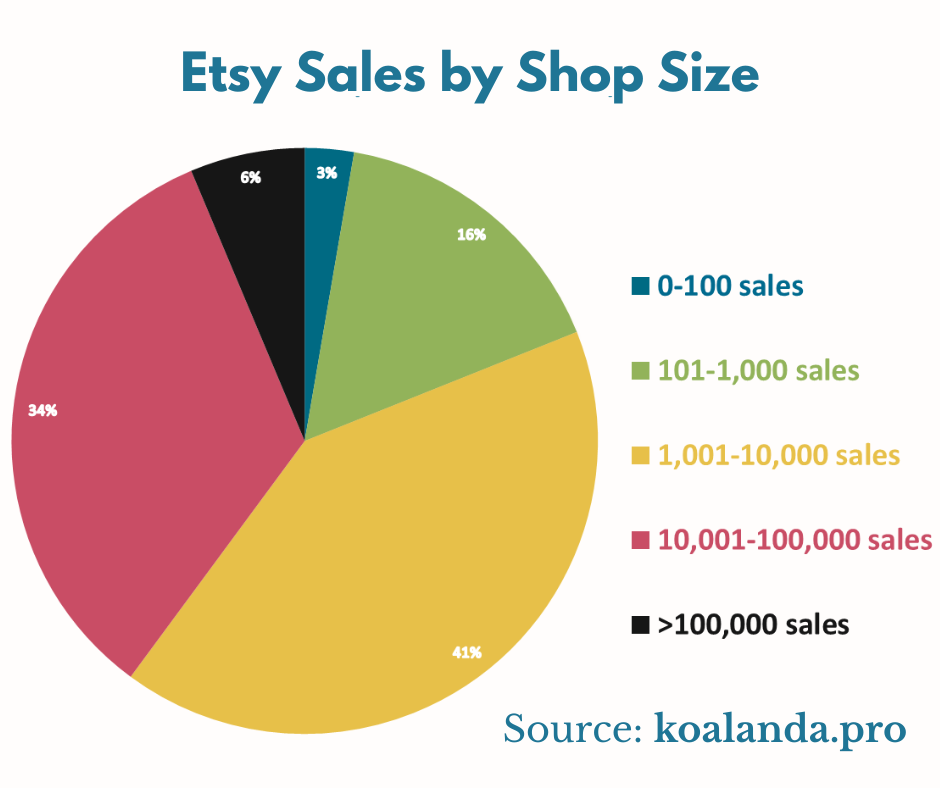Every business decision we take should be based on hard data, rather than guesswork and intuition. This is just as true when it comes to decisions about our Etsy business. Most sellers are constantly searching for information on Google or social media. Unfortunately, the answers they find there are usually not backed by data, but simply reflect the speculative assumptions of other sellers. And if we are able to have a look at the real data in such cases, we will see that many assumptions presented as fact on the web are actually myths. So, in this blog post we decided to bust 5 of the most popular myths about Etsy, using the data that Koalanda collects about shops on a daily basis.
Table of Contents
Myth #1: Sales multiply many times over during holidays
There is no doubt that people shop more on Etsy, or any other e-commerce platform, around holiday periods. This is especially true with respect to gift-giving holidays that are celebrated by almost everyone in all parts of the world, e.g. Christmas. But how much do people really shop during such holidays? Many sellers seem to believe that sales increase manyfold, and not just once, but several times a year (around every bigger holiday). However, the reality is quite different.
During the greatest shopping spree that took place in November 2021, and specifically on the strongest days around Black Friday, the average increase in Etsy sales was about 2 times (on a daily basis). Of course, things look very different in the separate categories. For instance, the spike in Bags & Purses, Home & Living, and Jewelry was much more significant than in Craft Supplies & Tools. Looking at the data by country also reveals some interesting differences. However, if we focus on individual holidays, we will see that there are hardly any signs of a great Christmas shopping, for instance, still less of one that can be comparable to the shopping around Black Friday. The hopes of some sellers to witness a dramatic rise in sales around St. Valentine’s Day also prove futile.
You can find more detailed data in our blog post analyzing the Etsy sales in the period October 2021 – February 2022.
The presented graph clearly shows that even on Mother’s Day (8 May 2022 in the US, 27 March 2022 in the UK) or on International Women’s Day (8 March), there wasn’t a significant rise in sales on Etsy. Our data demonstrate that there wasn’t a noticeable increase in individual countries either (for instance the US and the UK).

To wrap up, we can say that there are holidays all year round, but that does not mean we should expect regular spikes in Etsy sales. The only exception according to the data is the shopping spree around Black Friday in the end of November.
Myth #2: There are little to no Etsy sales in January
In January 2022, social media were once again flooded with questions, such as “Am I the only one selling less,” “Can anyone sell anything in January,” etc. Everyone was under the impression that January had been a super weak month for all Etsy sellers. But the detailed analysis we published tells a very different story.

Overall, the Etsy market was not weaker in January and February 2022 than it was in October 2021. Of course, there are certain categories or countries for which this is not valid, but even in those cases, the decline in sales was much smaller than the expectations raised by the host of gloomy statements on social media. The main reason for this is that sellers often forget that they should be comparing their January sales with their sales in October of the previous year, rather than with the sales in the last two months of the year, when online shopping is at its peak.
Myth #3: It takes a long time for an Etsy business to take off
One of the most widespread myths out there is that it takes an awful lot of time to get that first sale on Etsy (and every next one after that). But the truth is that the road from 0 to 1 is not that cumbersome.
It is a myth that buyers will see you have no sales, and this will make them reluctant to trust your products. In fact, more often than not buyers like and purchase a particular product without looking at the seller’s shop (or whether it has 0 or 1000 sales).
The most important thing is to be prepared for what steps you need to take to be successful on Etsy. Make sure you have a solid start — publish at least a dozen listings optimized for Etsy’s search engine, with professional-looking images, and in the right market niche. You can get some help from a coach if you want to be sure that your listings will reach an optimal number of prospective customers. In the beginning, you might find it difficult to follow all the advice in the Seller Handbook.
It is a good idea to start with some ads, which can help you get a few quick sales. Etsy loves sellers who can and know how to sell. And every sale is an opportunity for a positive review, which will improve your ranking in the search results.

Well, don’t wait until it’s time for your first sale; get busy and do all that work in advance! It’ll pay off quicker than you think.
Myth #4: Etsy is only good for US shops
It is true that the majority of buyers and sellers are from the US and that the most successful shops are also from the US (see which countries have the most successful Etsy shops here). However, this does not mean that Etsy only works for US shops. Our data demonstrate that the probability of a shop closing or failing to develop is much higher for US shops than for shops in many other countries.

Only 20% of all US shops have more than 100 sales in total. The USA ranks 24th out of all countries by this measure. For comparison, the percentage is close to 40% for shops from China and Ukraine. More successful than the US by this yardstick are also the sellers from Hong Kong (28%), Bulgaria (27%), Lithuania (26%), Nepal (26%), Latvia (25%) and Israel (25%).
The other criterion we decided to examine is the percentage of shops that closed up in the past year. The percentage is highest for Vietnam (76%), Indonesia (69%) and Mexico (61%). More than 50% of shops closed up in Brazil, Turkey and China over a single year. The percentage for the US is 32%, but many other countries are doing better in this regard. These include Israel, New Zealand, Slovenia, Greece, Bulgaria, Lithuania, Canada and Great Britain (between 22% and 27%).
Let’s not forget that in recent years, Etsy as a company has made serious efforts to further penetrate the European market. This is evident from key business decisions, such as the deal with Dawanda in Germany (2018) and the acquisition of Depop in the UK in 2021. And we can all see the aggressive sales campaigns in European countries, such as Summer Sales 20manyfold22 in France.
This all points to the fact that Etsy does not plan on staying within the market of North America, but is set on securing a greater presence in Europe.
Myth #5: Etsy is a platform for small sellers
Etsy is a platform that primarily attracts small and independent creators, and buyers interested in the products of such creators. However, there are no restrictions on how big shops can be. With Etsy’s development, the number of large shops is also growing. Very often, people are left with the impression that Etsy’s growth is mainly dependent on the large shops. You can find more information about the big and small Etsy sellers here – Is Etsy Favoring the Big Sellers. Let’s see what the data will show.

Around 20% of all Etsy sales made in the last 6 months belong to sellers with up to 1000 overall sales. The remaining sales are more or less evenly distributed between sellers with 1001 – 10,000 overall sales and sellers with more than 10,000 overall sales. Therefore, it is clear that Etsy is not a platform exclusive for small sellers, but a space where you can continue to grow your developed business.
Conclusion
So, next time when you read a strongly worded opinion on social media, take it with a pinch of salt. Keep in mind that even if 100/100 comments on Facebook or Twitter follow the same direction (for instance, that there are fewer sales in January than any other time), it does not necessarily mean they are correct. Maybe the people making sales are not in that social media group. Or maybe they don’t want to boast, when everyone else is weeping over a decline in their sales.
Whatever the reason, remember that Etsy currently hosts about 5 million active shops, and the opinion of several dozens of them does not necessarily reflect the real state of the market. Hard data is what you should rely on when taking important decisions about your Etsy business. This is precisely why our Koalanda team will continue to provide you with real and up-to-date data through our instruments and the analyses we publish.





